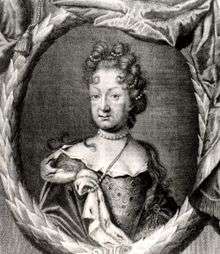Sophia of Saxe-Weissenfels, Princess of Anhalt-Zerbst
Sophia of Saxe-Weissenfels (also: Sophie; 23 June 1654 in Halle an der Saale – 31 March 1724 in Zerbst) was a member of the Albertine branch of the House of Wettin, and a princess of Saxe-Weissenfels and Querfurt by birth and by marriage Princess of Anhalt-Zerbst.
Sophia of Saxe-Weissenfels | |
|---|---|
| Princess of Anhalt-Zerbst | |
 | |
| Born | 23 June 1654 Halle an der Saale |
| Died | 31 March 1724 (aged 69) Zerbst |
| Noble family | House of Wettin |
| Spouse(s) | Karl William |
| Father | August, Duke of Saxe-Weissenfels |
| Mother | Anna Maria of Mecklenburg-Schwerin |
Family
Sophia was the third daughter of the Duke August of Saxe-Weissenfels and his wife Anna Maria of Mecklenburg-Schwerin, daughter of Duke Adolf Frederick I of Mecklenburg-Schwerin. She was named after her paternal great-grandmother, Sophie of Brandenburg, Electress of Saxony.
Marriage and issue
She married on 18 June 1676 in Halle with Karl William, a son of John VI, Prince of Anhalt-Zerbst from his marriage to Sophie Auguste of Schleswig-Holstein-Gottorp. Unlike most royal couples of the era, Charles William and Sophia shared a bedroom in their new baroque palace. This suggests that they may have married out of love.
They had the following children:
- John Augustus (1677–1742), Prince of Anhalt-Zerbst
- Charles Augustus (born: July 2, 1678 in Zerbst, died: 1 September 1693 ibid), Prince of Anhalt-Zerbst
- Magdalena Augusta (1679–1740), Princess of Anhalt-Zerbst
Death and burial
Sophia died at the age of 69 years in her rooms at Zerbst Castle and was buried on 7 June 1724 in the princely tomb in the St. Bartholomew's Church in Zerbst. In 1899 Duke Duke Frederick I of Anhalt, ordered the implementation of a princely family vault in the Castle Church in Zerbst Castle. After the destruction of the castle in 1945, the remains of the damaged coffins were transferred back to St. Bartholomew.
External Links and sources
- Publications by or about Sophia of Saxe-Weissenfels, Princess of Anhalt-Zerbst at VD 17
- Entry in ThePeerage.com
- Johann Hübner's ... Three hundred and thirty-three Genealogical Tables, Table 170
- Schloss-Zerbst.de